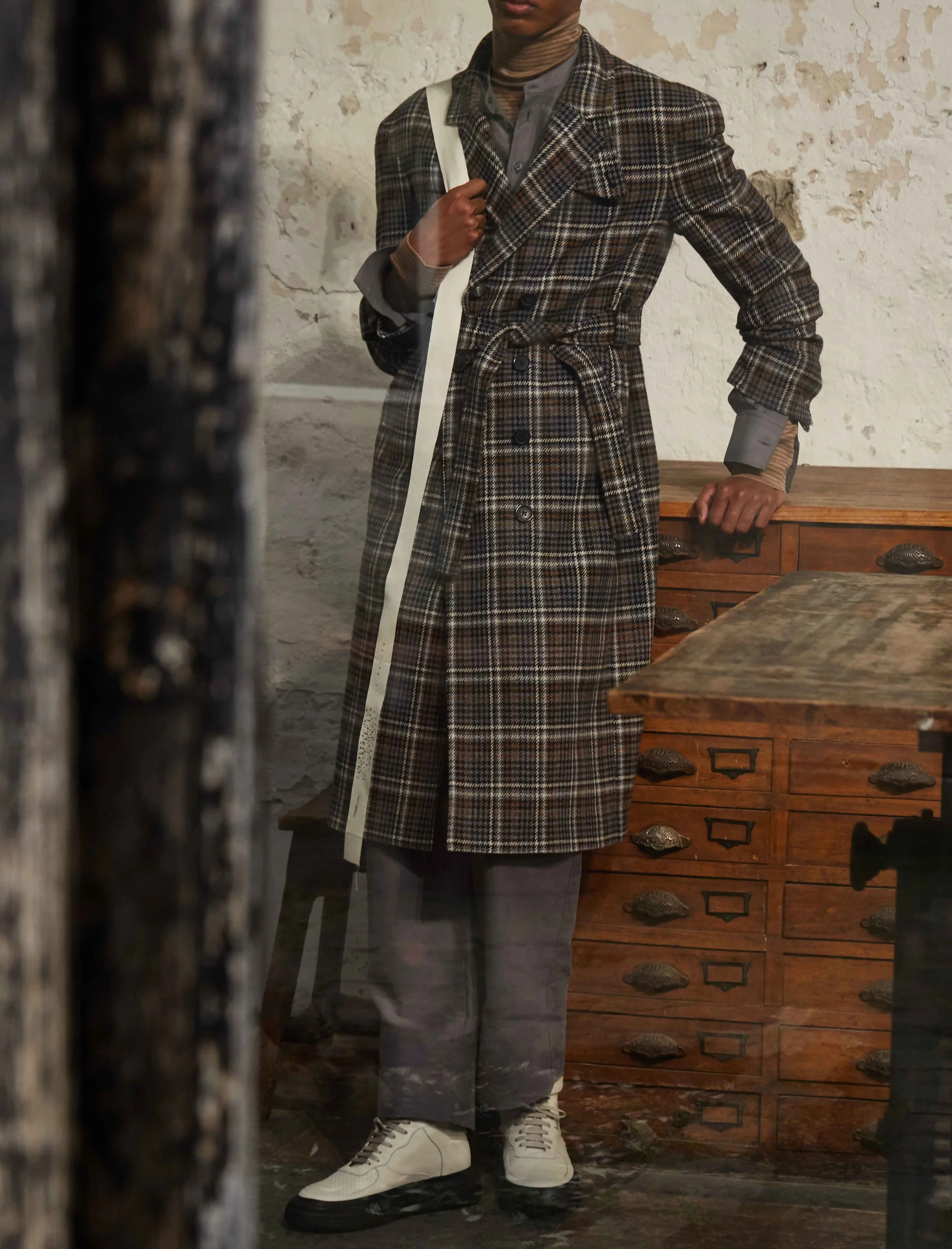BOHEMIAN RHAPSODY
Designer Federico Curradi mixes romance and restraint to establish new codes for the menswear line at the legendary Parisian fashion house Rochas.
BY MAX BERLINGER
PORTRAIT AMIT ISRAELI
PHOTOGRAPHY KEVIN OHANA
After a short hiatus, the French label Rochas has revived its menswear line this time with Italian designer Federico Curradi at the helm. Rochas is a quintessentially Parisian label, founded in 1925 by Marcel Rochas and has subsequently become synonymous with a rarefied and romantic way of dressing. Mostly known for its sensual femininity - think lace and satin - it launched a men’s line for the first time in 2017. Curradi, who comes from brands known for their sense of distinctly Italian swagger - labels like Ermanno Scervino, Iceberg, and Roberto Cavalli - and designs his own namesake line of romantic ready-to-wear as well, has been brought in to give the men’s offering a modern look and a new perspective.
Curradi, who has a virile energy, athletic frame, and tattooed arms, lives in the Florentine countryside with a menagerie of farm animals that includes horses and, believe it or not, wolves. His aesthetic is imbued with a rugged masculinity, mixed with appealing louche bohemianism. With an eye on rich, opulent fabrics and elegant, graceful silhouettes, Curradi’s aesthetic is artsy and undeniably sexy. At first glance, he’s an unexpected choice for Rochas, a brand known for its delicate, supremely feminine womenswear. Still, with virtually no history of men’s designs, Curradi was able to conjure and create his idea of who the Rochas man was from scratch, basing his first collection on the designer, Marcel Rochas, himself, as well as the 1956 photo book “Love on the Left Bank” which depicted Paris’ sensual, artistic bohemian scene.
His debut was reserved and tasteful, a perfect balance of his unrestrained look and Rochas’ more buttoned-up, poised reputation.
Tell me about your childhood. Where did you grow up?
I grew up in Florence and moved to the Tuscan countryside like 15 years ago. I live there with my animals. I like country life. I think it’s good to get some rest in the middle of nowhere, you know?
Animals? What kind? How many?
Oh, I have a lot of animals, it’s like a zoo. I have horses, I have cows, I have chickens and cats.
It sounds like a farm!
It’s a pleasure farm, not for business.
But can you milk the cows or have eggs from the chickens?
Oh yeah. That’s one of the benefits of having a farm. I have a whole supermarket at home. Especially in the summertime, I don’t even have to go to the grocery store.
When you were a little boy, when did you first think about designing fashion?
I went to art school, and then had a chance to work with a tailor in Florence and that’s where I discovered my passion for clothing. That’s where I learned how to make them. It has turned into true love. I learned how to do this job the old school way. I discovered that it’s really close to the arts and you get to meet a lot of interesting people, people who are different, who are unusual, which I find interesting. I like to share my life because in fashion, in a way, you’re putting your life into your work. It’s very lucky if you’re able to do something that you love and allows you to express yourself.
So did you go to design school or you learned everything from the tailor?
No, I just worked with the tailor. I recommend this to everyone because it’s very tough, much harder than school. You can learn much more. My story, how I got into this line of work, it’s very different than other people who went to school. I created my own line, under my own name, when I was around 22. And then at 25, I was the head designer at Ermanno Scervino, which is a Florentine brand, it’s huge here. I did the first season for the men’s line. I was also designing some sportswear, especially denim, for women. It was really successful and that’s how my career took off.
Why did you start your career with your own line? That seems hard.
Because working with men’s tailors was good but, in a way, it was quite boring. Always the same, always working with older people, and if they are young they are old inside, you know? I had to keep my point of view about clothing inside me. When you’re young you want to do show pieces, but you don’t understand the balance of also creating wearable things. The new things, they are super-cool, but they were probably only cool to me.
You don’t know how to create a business unless you can make real things, you know what I mean? It was really hard and I had to do a lot of things wrong to discover my taste. It’s a long process. Every day I learn something, especially me, I see something wrong in everything. Everything I see, I see something wrong, but that’s part of the job.
When you design for another brand and not for yourself, does that help you create the balance you’re talking about?
Yeah, sure. When you work with other brands, it’s important to understand the brand DNA and to try to find a way to consider its heritage. To find the balance between what the brand is and what you can bring to it. In my opinion, that’s the balance of the brand. For example, I love to work with different fabrics. I bring that to the brand.
Fashion is thought of as something that’s made every six months. But for me, I spend a lot of time thinking and working. So to think that it ends every six months, I try to make pieces that are more beautiful. Real pieces that people will buy and can reuse after one or two years. That’s what I love to do. I have some stuff in the closet that I can wear in different ways. That’s something I like to do, to make something that’s not just for one season. That’s my idea of fashion.
So tell me about your position at Rochas.
With this job, I would say I’m so happy to work for a very important Parisian brand like Rochas. Also to start the men’s collection. The Fall-Winter 2019 collection, which was my first collection, was like a blank page. It was a cool opportunity but there was a lot of pressure, because everyone was asking what I was going to do.
The idea was to express a new way of luxury. Something wearable that you can wear it in the daytime, nighttime, and even 24-hours a day. I love the idea of how we express our feelings, and to find the balance between the artsy guy in Paris and modernity. We also had to find the heritage and bring it into this moment. Part of that was this idea of not using any plastic and to make the packaging recyclable, which is really great.
It was a lot of ingredients. I’m really happy with how we went around the idea of poetry, how we wanted to explain the ideas of the bohemian, intellectual, Parisian soul. An expression of Parisian nonchalance.
Because there wasn’t a men’s collection, how did you get your ideas?
I did a lot of research on Marcel Rochas the man and on the brand itself. When you think of Rochas you think of luxury, of haute couture. I started thinking about what real luxury means for a man today. To me, it’s when you feel really comfortable with your outfit. I like it when people put their personality first before their outfit. I thought it was cool to represent the more artistic side of Marcel Rochas, rather than the haute couture. His creative side more than his clothing. For a woman it’s more like the history of the brand, but for the man, it’s more like Mr. Rochas himself, his feeling for the arts, how he got his inspirations, the vibe of Paris, the environment around him. I looked at the book “Love on the Left Bank.” I thought it was really good to get the suggestions and references from it. I love the reportage. This book is from the late 1950s, but it’s so modern, it feels very right now. I also looked at a lot of Modigliani for the color palette. He’s Italian and moved to Paris, I love him a lot. I wish for his talent.
So what’s happening next?
For my second collection, we want to explore the same man, the same nonchalance, the same artsy guy, but wanted to explain more. We went to Paris in the mid-1940s, after the end of the second World War. There’s this book, it’s German, and it’s from the first female reporter from World War II and so it’s this reference between tailoring, really masculine and formal suits, and also … well, it’s a lot of other things. But in the end, it’s quite real and infused with a lot of creativity and art. So we can be less angry.
Was the second collection harder or easier to design? Easier, I think. I like that it’s about a maker, an artistic guy but with a touch of military, but also with feminine embroidery. I like when there’s a lot of weird things that come together. Not everything has to be beautiful, not everything has to be pretty. I like it when you find your own perspective, like when you take so many things and add them together and find your own balance.
Going forward, what do you want people to think of when they think of the Rochas man?
I want them to them to think it’s a modern brand. Not because it’s synthetic or because it’s sharp, modern because it’s luxury, because it’s wearable, because we take care of the environment, because it represents what a man needs right now. It’s not just a brand that does things for show, but it has a soul.
To find that soul, is it important to look into the past?
Oh yes, really important. Rochas should have a heritage. It’s really important to look to the past to create something new. You have to understand the past. Fashion has changed and the ideas of beauty have changed, you know? In a world where everything is on social media and everything gets old very quickly - you put a picture on Instagram and it’s gone - it’s not how it was 15 years ago. I think that it’s important to look at the past to make the brand authentic, relevant and believable.



